Modern protective suits for armoured fighting vehicle crews
Splinters are produced by kinetic energy projectiles such as APFSDS after penetrating the main armour and creating spalling fragments that not only disable internal equipment but also disable the crew inside. Occasionally, spalling is also created after a projectile does not penetrate a vehicle armour plate but causes the internal layer of armour to crack and shatter, causing a dense cloud of splinters that can reach weights of up to 500 grams.
Fragmentation is also created after the main armour is penetrated by shaped-charge ammunition (HEAT-FS). This can create a burst of splinters of around 140 to 260 fragments in an 80°-100° cone. Lightly armoured vehicles being hit by smaller calibre ammunition such as 7,62mm/12,7mm undergo the same effect, just at a smaller scale, due to thinner armour plates and generally smaller projectiles.
The probability of the crew being incapacitated by splinters is high due to the density of fragments and the wide dispersion angle. 2 groups of splinters are created after armour penetration.
- Group 1 consist of fragments weighing 1-3 grams, travelling at a velocity ranging from 500m/s-600m/s. These fragments constitute 70% of the entire splinter group.
- Group 2 consists of larger fragments that come from internal armour layers that crack and shatter; these don't cover as much area, around 3%-5% of the vehicle's volume. These fragments cause heavy damage but are not numerous.
- Individualized protection
- Internal anti-fragmentation lining
Individualized protection is applied to crewmembers and ensures the safety and protection of the operator inside and outside of the vehicle. Crew loss can occur not only after the main armour is penetrated but also due to excessive heat. Excessive heat takes place after a fire breaks or existing ammunition detonates.
Suits made from heat and fire-proof fabrics are capable of resisting flames and temperatures exceeding 1,100°C and hold away the higher temperature from the human body for around 20 seconds are rather effective when an internal fire breaks out.
A protective suit was developed by NII Spetsmashinostroyeniya in 1998-1999. The suit consists of 3 parts: a fire-proof overall, which protects 80% of the human body from open fires and temperatures reaching 1,100°C for 15-20 seconds, an anti-fragmentation helmet worn over the standard communication headset TSh-3/TSh-4 and an anti-fragmentation body armour vest, which protects vital organs from fragments weighing up to 1g-2g with a velocity of 500m/s. The entire kit weighs around 6kg.
 |
| 1 - fragment-proof headset lining; 2 - bullet/fragment-proof body vest; 3 - fire-proof jumpsuit |
The suit uses Armos and Rusar fabrics as the main material. Oxalone-based hybrid fabric and non-woven fire-proof materials are also used. All materials are made to resist water, oil, gasoline, additionally, they can resist decontamination compounds and chemicals.
Armos is a domestically produced fabric that is an alternative to Kevlar. Rusar and its later derived variants Rusar-S were developed later as a para-aramid fibre.
Crew protection kits after live-fire testing; a) fabric used in the main protective vest after stopping a fragment weighing 2 grams and travelling at a speed of 460m/s; b) lateral cutout of composite layer used in the helmet after being hit by several fragments weighing 1.1 grams and travelling at a velocity of 460m/s. (Left; velocity of 460m/s - Right; velocity of 520m/s). Tests were conducted using a fragmentation imitator.
The individual protection kit has undergone trials on all types of armoured vehicles. Ergonomic tests have been carried out in different environments ranging from -40°C to +40°C, humid and dry conditions. To test out the full usage of this kit, crewmembers performed their standard duty operations like mounting and dismounting their vehicle, performing marches and using weapons.
 |
| 1 - Tank crew; 2 - Commander performing his duty; 3 - Gunner-operation using the main sight |
Protective Kit
The purpose of this protection kit is to ensure protection to the head, neck and body from secondary splinter fragments inside of armoured vehicles, from small arms fire, land mine fragments as well as from open flames. The helmet integrates the same communication equipment in the form of the TSh-4 headset.
The suit is available in 3 sizes and can be adjusted to personal liking. The whole suit features proper ventilation. Several belt hooks are attached to the suit in case of an emergency where a crewmember has to be pulled out of a vehicle. Integrated pockets to fit specific crew items.
The kit is composed of:
- Rigged headset in place of the standard Tsh-4
- Body armoured vest
- Fireproof vest
The suit is designed to protect the human body from open flames for around 10-20 seconds. It comes in 2 different seasonal colours; winter and summer. The elbows, knees and lowermost back of the suit are fitted with additional heat-resistant cushions.
 |
| Whole outfit kit. |
 |
Crew members are being pulled out of the vehicle using the aforementioned belt hooks. Used for incapacitated members. |
 |
| Performing dampening pad bending on the elbow part of the jacket. |










Comments
Post a Comment